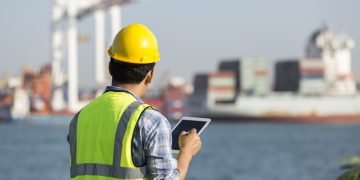Given the many difficulties involving in suppressing battery fires, particularly at sea, focusing on loss prevention measures is crucial, whether batteries are transported within EVs or as standalone cargo, according to a new risk bulletin from marine insurer Allianz Global Corporate & Specialty (AGCS).
As a key component of electric vehicles (EVs) or electronic devices, the transport of highly inflammable lithium-ion (Li-ion) batteries is increasingly impacting shipping safety as demonstrated by a number of fires on vessels such as roll-on roll-off (ro-ro) car carriers and container ships.
Shipping losses may have more than halved over the past decade but fires on board vessels remain among the biggest safety issues for the industry. The potential dangers that the transportation of lithium-ion batteries pose if they are not stored or handled correctly only add to these concerns, and we have already seen a number of incidents
explained Captain Rahul Khanna, Global Head of Marine Risk Consulting at AGCS.
In fact, the pressing issue of fires onboard was prominent at Allianz’s latest Safety and Shipping Review. Namely, AGCS noted that there have been over 70 reported fires on container ships alone in the past five years.
Fires often start in containers, which can be the result of non-/mis-declaration of hazardous cargo, such as chemicals and batteries – around 5% of containers shipped may consist of undeclared dangerous goods.
Fires on large vessels can spread quickly and be difficult to control, often resulting in the crew abandoning ship, which can significantly increase the final cost of an incident.
Hazards and causes
There are four main hazards associated with Li-ion batteries:
- Fire (Li-ion batteries contain electrolyte, an ignitable liquid);
- Explosion (resulting from the release of ignitable vapor/gases in a confined space);
- Thermal runaway (a rapid self-heating fire that can cause an explosion);
- Toxic gases that these hazards can produce.
According to Allianz, the most common causes of these hazards are:
- Substandard manufacturing of battery cells/devices;
- over-charging of the battery cells;
- over-temperature by short circuiting
- damaged battery cells or devices.
In most shipboard incidents a thermal runaway event can be a significant possibility unless immediate action is taken by the crew, such as suppressing a fire with copious amounts of water over a long period of time. However, this can be extremely challenging due to factors such as early detection being difficult, a shortage of crew members on board, and if the vessel’s firefighting capabilities are inadequate
said Captain Khanna.
Loss prevention measures for EVs on car carriers and in containers
Among others, recommendations to mitigate the fire risk include:
- Ensuring staff are trained to follow correct packing and handling procedures and that seafarers have had Li-ion battery firefighting training;
- Checking the battery’s state of charge (SOC) is at the optimal level for transportation where possible;
- Ensuring that EVs with low ground clearance are labelled as this can present loading/discharging challenges;
- Checking all EVs are properly secured to prevent any shifting during transportation.
- In transit, anything that can aid early detection is critical, including watchkeeping/fire rounds and utilizing thermal scanners, gas detectors, heat/smoke detectors, and CCTV cameras.
The report also highlights a number of measures that can help ensure safe storage of Li-ion batteries in warehouses, noting that large-format batteries, such as those used in EVs, ignite more quickly in a warehouse fire than smaller batteries used in smartphones and laptops.
Among others, recommendations include:
- Training staff in appropriate packing and handling procedures;
- Establishing an emergency response plan to tackle damaged/overheating batteries and a hazard control plan to manage receiving, storage, dispatch and supervision of packaged Li-ion batteries;
- Preventing the exposure of batteries to high temperatures and ensuring separation from other combustible materials;
- Prompt removal of damaged or defective Li-ion batteries.
If the maritime industry is to improve its incident record related to the transportation of lithium-ion batteries all parties involved in the supply chain must understand the hazards involved, the most common causes and the problems associated with transporting in commerce
says Captain Randall Lund, Senior Marine Risk Consultant at AGCS.
Ro-ro and car carrier risks
Ro-ro and car carrier vessels can be more exposed to fire and stability issues than other vessels and require additional emphasis on risk management. To facilitate carriage of automobiles the internal spaces are not divided into separate sections like other cargo ships.
The lack of internal bulkheads can have an adverse impact on fire safety and a small fire on one vehicle or battery can grow out of control very quickly.
Vehicles are not easily accessible once loading has been completed. The large volume of air inside the open cargo decks provides a ready supply of oxygen in case of fire.
A number of accident investigations have revealed that pre-sail away stability checks were either not carried out as required or were based on inaccurate cargo information.
In many cases cargo was not fully secured prior to sailing and inadequate lashing of cargo such as EVs could lead to a thermal runaway and ensuing fire. For cargo ro-ro and vehicle carriers, improved cargo securing and weather routing should be considered.
Other relevant findings from the risk bulletin:
- AGCS analysis of over 240,000 marine insurance industry claims over the past five years (with a value of €9.2bn), shows that fire/explosion (from all causes) is the most expensive cause of loss, accounting for 18% of the value of all claims.
- The number of fires (from all causes) on board large vessels has increased significantly in recent years. Across all vessel types, fire/explosion was the second top cause of the 54 total losses reported in 2021, second only to foundered. Over the past decade fire/explosion ranks as the third top cause of loss overall, accounting for 120 out of 892 reported total losses, behind foundered (465) and wrecked/stranded (164).
- Ro-ro and car carriers can be more exposed to fire and stability issues than other vessels. To facilitate carriage of automobiles the internal spaces are not divided into separate sections like other cargo ships. The lack of internal bulkheads can have an adverse impact on fire safety and a small fire on one vehicle or battery can grow out of control very quickly. Vehicles are not easily accessible once loading has been completed. The large volume of air inside the open cargo decks provides a ready supply of oxygen in case of fire.



































































This article is devoid of mitigating on vessel fires and especially Li-Ion events with Encapsulation Agents (EA) like F-500EA. It’s highly likely that the author simply is unaware of this technology, but, in this day and age, I consider such ignorance to be egregious (at worst) and disingenuous (at best). I do not sell this stuff, but having witnessed the demonstrations then studied up on the science, I think that EAs are much more of a value than foam because:
1) Lower cost over time.
2) More expedient and efficient fire and combustion chain suppression, as well as rapid heat disbursement.
3) Lack of PFOS/PFAS and a byproduct that is basically ketones.
Seriously, I think it is downright criminal that the whole of the Maritime industry has failed to implement encapsulation agent technology into its basic fire suppression requirements.